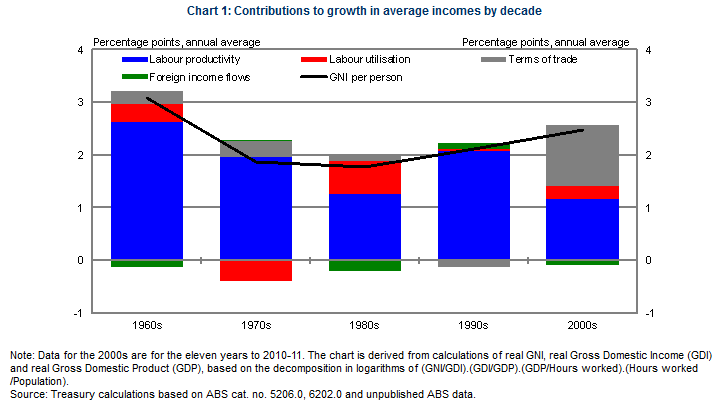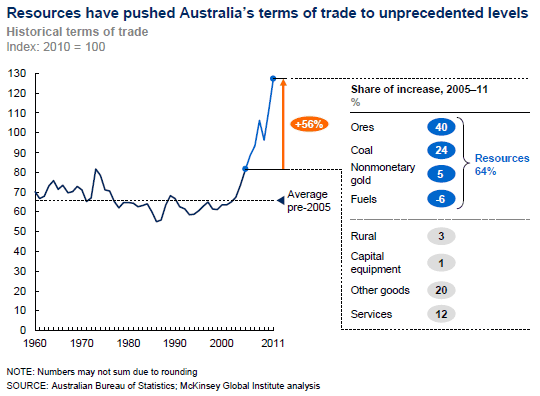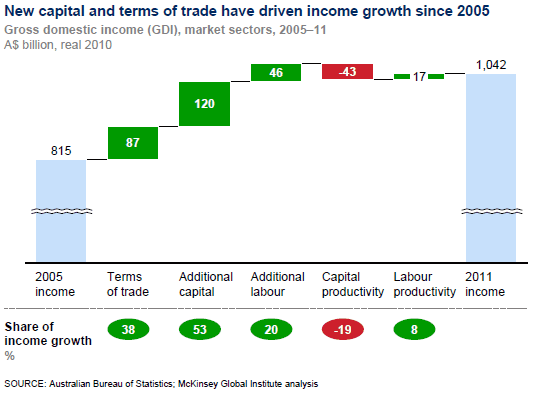
Feedback loops are an important concept in finance and economics. In a nutshell, positive feedback loops are pro-cyclical in that they act to make an economy more volatile by accentuating booms and then busts. By contrast, negative feedback loops are counter-cyclical in that they act to reduce volatility and make an economy more stable by mitigating boom/bust cycles.
Australia faces the risk of a positive feedback loop with respect to Australia’s state and federal governments, which have pledged to return to surplus in the face of deteriorating global and local economic conditions.
It is now becoming mainstream that Australia is going to be adversely affected by the combination of lower commodity prices (falling terms-of-trade) and the reduction in planned mining investments, both of which will act to reduce disposable incomes and jobs.
In July, the Australian Treasury released analysis showing that around half of the growth of average incomes experienced over the 2000s was caused by the one-off rise in the terms-of-trade (see below chart), and that income growth and the economy would face stiff headwinds in the future as the terms-of-trade unwinds and subtracts from national income.

The Treasury’s analysis was followed-up a month later by an excellent report from McKinsey Global, which estimated that 90% of the growth in Australian incomes in the seven years to 2012 was caused by the mining boom – via the rising terms-of-trade and the boom in mining-related investment – and warned that Australia could experience little or no income growth over the next seven years if:
- the terms-of-trade trended back towards its long-run average;
- only two-thirds of advanced resource projects and one-third of planned projects come to fruition; and
- there is no improvement in productivity growth.


As noted by Houses & Holes yesterday, eminent Australian economists – Ross Garnaut and Bob Gregory – have now entered the fray, warning that Australia faces sharply lower living standards as the mining boom unwinds and arguing that the Government should step-up infrastructure investment to support growth. There is more on this today at the AFR.
There is oodles of economic research available on how a positiveterms of trade shock shock should be managed via monetary and fiscal policy. But, as Houses and Holes pointed out last year, there is surprisingly little literature on the subject of how to handle a negative terms of trade shock. It does not seem to have occurred to anyone that all good things must come to an end. There is one 2006 study by the the Australian Bureau of Statistics that did model a similar circumstance to the one we find ourselves approaching (find it below). It concluded:
When the domestic economy slows, but cash flows from a terms of trade effect are strong, businesses may be able to afford to retain staff they otherwise would have had to lay off. Businesses with a longer term outlook on market conditions may be able to maintain a stable rate of employment growth. In addition, for a given level of domestic output, the additional income induced by a rising terms of trade need not be distributed solely to shareholders (in the form of dividends) and to existing employees (as wages and salaries). It can also be retained for investment and / or hiring purposes. It is therefore not surprising to observe stronger than expected employment growth during periods of a strong terms of trade.
The growth rate (or business cycle) of GDP usually leads employment by around one to two quarters. However, this relationship can be distorted by various disturbances (or shocks) which impact upon the economy. Terms of trade shocks may alter the appearance of this relationship substantially. For example, if the economy has slowed but a terms of trade effect has prevented a similar slowdown in employment growth after the usual two quarters, then this lag will appear to be longer once the slowdown does occur. Alternatively, if forward-looking businesses maintain buoyant employment growth in anticipation of the next upswing in growth, then employment will appear to lead GDP once this upswing does eventuate.
As H&H recounted last year, what these two paragraphs describe is a kind of false economy that the high terms of trade presents to business. That is, the big income flows in the economy mask underlying production weakness that would usually result in job losses. When the terms of trade shock comes along, therefore, there is a relatively small impact on GDP but a quite high impact on unemployment.
This makes a certain amount of sense. Yet the rhetoric coming out of Australia’s federal and state governments suggests that an increased fiscal response to support employment during any mining downturn is unlikely, with each committing to return their budgets to surplus come what may.
The federal government had expected to raise $3 billion per year from the new minerals resource rent tax applying to iron ore and coal. However, some analysts now predict that budget revenue could be cut by up to $10 billion due to the combination of falling mining profits (which reduces company tax receipts) and reduced mineral rent taxes.
The resource states of Western Australia and Queensland are also under pressure from falling mining royalties, which are applied to iron ore and coal exports. Western Australia was this year expecting to raise 17% of its revenue from iron ore royalties. The recent falls in the iron ore price is now expected to wipe $1.2 billion from Western Australia’s Budget – pushing the state into deficit to the tune of $1 billion. Similarly, Queensland is facing a $500 million revenue shortfall as the coal price declines; although the announced increase in coal royalties will offset some of the fall.
With lower commodity prices placing increasing pressure on government finances, there is now the risk that Australia’s state and federal governments could be forced to further cut back on spending and employment in a bid to balance their budgets. For instance, asked recently on what he would do if the iron ore price didn’t recover, Federal Treasurer, Wayne Swan, said it would make his budget task harder and that the Government would be forced to find additional savings:
“We are absolutely committed to delivering a surplus in 2012-13,” he said. “The government has a proven track record of delivering savings and we remain able and willing to do it again”.
Part of the federal and state government’s desire to return to surplus has arisen from the credit ratings agencies, which have threatened ratings downgrades in the event that they loosen the purse strings and/or government finances deteriorate markedly.
However, the pledge to return the Budget to surplus, if maintained, risks creating a positive feedback loop between commodity prices (the terms-of-trade), budget revenues, and the economy. Every time commodity prices fall, causing a reduction in budget revenues via lower mineral rent taxes/mining royalties and reduced company taxes, Australia’s governments would be forced to respond in-kind by cutting public sector spending and jobs. Such moves would obviously place further downward pressure on the economy, worsening any mining-related downturn.
The mining boom has been a massive bonanza for the Australian economy. However, if Australia’s authorities are not careful, its unwinding could be just as pervasive on the downside.
Twitter: Leith van Onselen. Leith is the Chief Economist of Macro Investor, Australia’s independent investment newsletter covering trades, stocks, property and yield. Click for a free 21 day trial.

